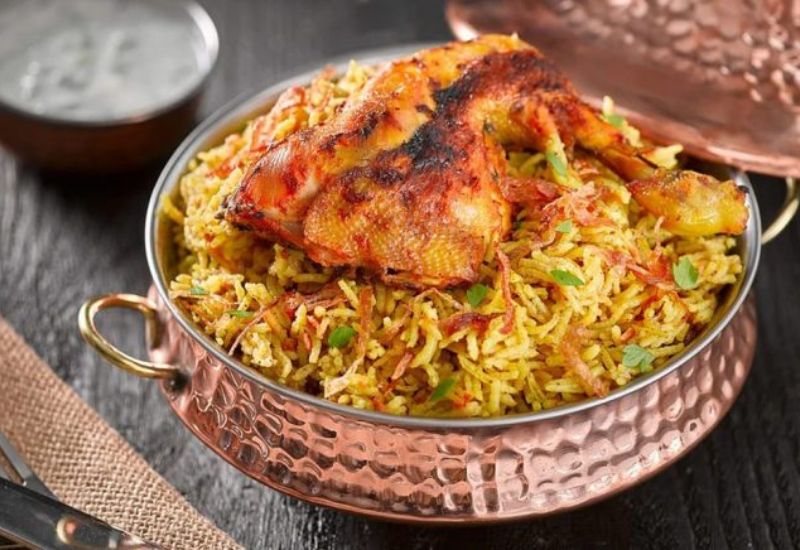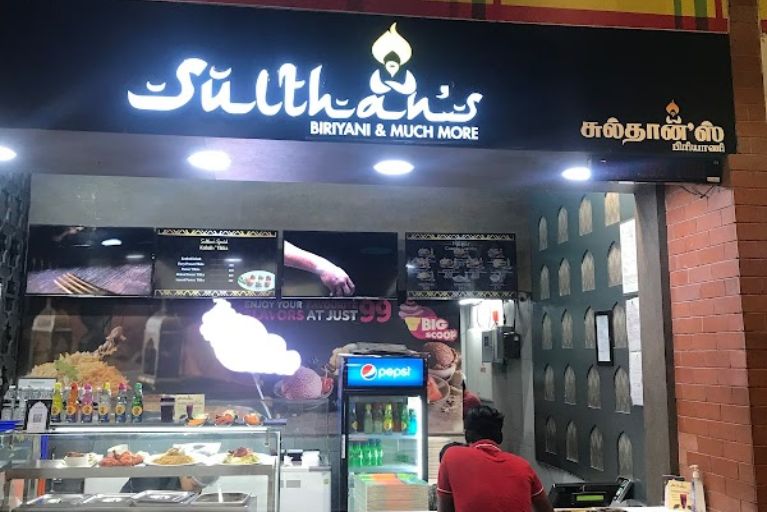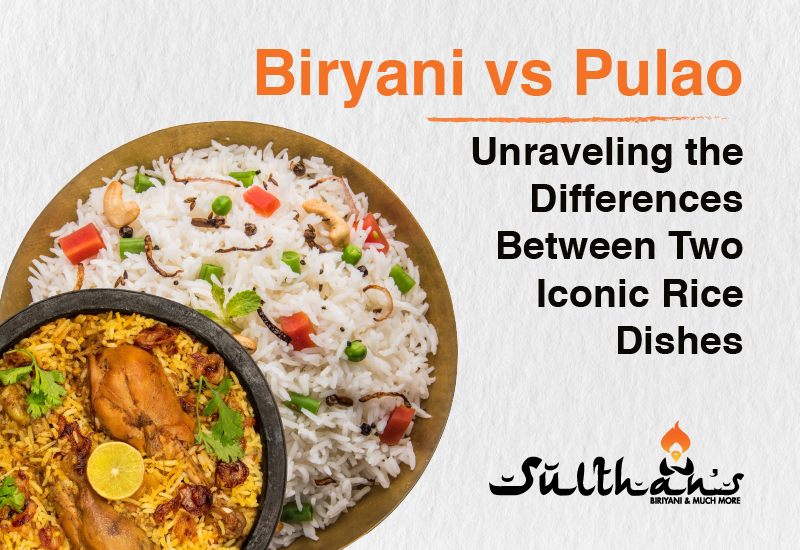Introduction
South Asia has centuries-old, rich traditions weaved throughout its gastronomic fabric. Rice is a fundamental component of this culinary legacy, appearing in each and every dish. Because of its adaptability, two classic dishes—pulao and biryani—have been created.
These dishes, whose origins are steeped in the subcontinent’s historical chronicles, represent more than just food; they are symbols of cultural festivities and family get-togethers.
The complex, multi-layered, flavourful masterpiece that is biryani is served during celebrations, while its more straightforward but no less delicious counterpart, pulao, is served on regular tables. When combined, they present the richness and variety of South Asian food, enticing us to go on a flavour-filled voyage through the core of culture.
Historical Origins

The fascinating fusion of myth and history is required to trace the origins of biryani. Babur, the Mughal Emperor, is credited with introducing the popular Indian cuisine, biryani, to the subcontinent.
In Central Asia, he developed a meal called pilaf that he fell in love with, tailoring it to the local palate to create what is now known as biryani. The dish’s origins are given a romantic touch by this tale.
In history, the Mughal and Delhi Sultanate eras are when biryani first appeared. Regional variations of biryani emerged from the refinement of recipes by royal kitchens.
Hyderabadi Biryani is a blend of Mughal and Telugu culinary traditions, and it was greatly influenced by the Nizams of Hyderabad. The development of biryani is evidence of India’s inventive cuisine and wide range of cultural influences.
Pulao’s historical voyage exposes its deep-rooted heritage over two thousand years in ancient classics like the Mahabharata and Ramayana. Pulao is portrayed in early sources as a meal fit for kings and lavish parties.
Pulao changed as it travelled across many areas and cultures over time. Variations arose that included regional spices and ingredients. As an alternative to the more complex and multi-layered Biryani, pulao developed into a versatile dish that was loved for its flavour and simplicity. With their distinct histories and flavours, both dishes remain essential components of the intricate web of Indian cuisine.
Ingredients: The Heart of the Matter
A tasty Indian dish known for its unusual ingredients and technique is called biryani. It has long-grain Basmati rice, which is highly valued for both its aroma and consistency. Speciality herbs and spices like saffron, cardamom, and cumin give it a unique flavour and scent.
There are many possibilities for every taste in biryani, as it can contain either meat or veggies. Layering is an important cooking method that alternates rice and meat/vegetables to allow flavours to blend while the food cooks.
Biryani is a beloved culinary treat known for its intricate yet well-balanced combination of flavours and ingredients, which is made possible by its careful assembly.
A pleasant dish with distinct components and a straightforward taste is pulao. Usually, it uses short-grain rice varietals, which produce a more tender texture. Compared to biryani, the spice combination used in pulao is gentler, resulting in a more delicate flavour profile.
For extra diversity, it includes a mixture of meat and veggies. Pulao is prepared differently from biryani, which involves intricate layering by cooking the rice and other ingredients together. This makes for a more harmonious one-pot meal that highlights the flavours of the ingredients.
Cooking Techniques
To acquire its rich and aromatic aromas, the painstaking preparation of biryani is a culinary skill. A crucial component is the Dum cooking technique. The rice is parboiled, and the meat (often lamb or chicken) is marinated before being stacked in a pot with a hefty bottom.
Fragrant spices, milk steeped with saffron, and caramelised onions are included in every layer. To trap steam, the pot is then covered with a tight-fitting lid or dough.
By cooking the biryani slowly over low heat, the flavours blend together and become more intense. The result of this combination of flavours is soft meat, fragrant rice, and a well-balanced spice mixture.
Conversely, preparing Pulao is a simple procedure. It is cooked in a single pot, where rice, veggies, and sometimes meat are cooked together. Aromatic ingredients like as onions, garlic, and ginger are sautéed before rice is added and quickly toasted. After that, add some water or broth, cover, and simmer until the rice is tender.
A perfect pulao requires a minimal amount of fuss and a balance of tastes. This is accomplished by varying the amount of seasoning, herbs, and spices to provide a subtle, agreeable flavour without being overly complex. The end result is a dish that’s easier to make than biryani and still tastes great.
Regional Variations

Famous rice dishes like pulao and biryani have unique regional variants throughout the Indian subcontinent. Southern Indian dish Hyderabadi Biryani is made with aromatic basmati rice, marinated meat, and a mixture of spices. North
Indian dish Lucknawi Biryani is well known for its dum-cooking method, which combines soft meat, flavourful spices, and rice that has been infused with saffron. A softer, more inclusive version of the dish that incorporates potatoes, Kolkata Biryani draws inspiration from Nawabi cooking.
Conversely, pulao demonstrates adaptability by incorporating many regional personas. In Kashmiri Pulao, aromatic spices, dried fruits, and saffron are combined with rice. While Kashmir’s Mutton Yakhni Pulao has mutton cooked with yoghurt and aromatic spices, Uttar Pradesh’s Tehri is a vegetarian pulao. The great gastronomic diversity of the subcontinent is exhibited in these meals.
Flavour Profiles
A symphony of flavours dances on the palate, giving the dish’s robust and aromatic character its distinctive blend of spices. This culinary masterpiece is enhanced exquisitely by the scent of saffron and rose water, which fills the air.
Pulao, on the other hand, adopts a more nuanced and thoughtful strategy. The minimal amount of seasoning lets the natural flavours of the ingredients come through in a harmonious blend. Pulao is a versatile option for people looking for a more subdued yet substantial lunch because of its lighter texture compared to the powerful Biryani, which provides a refreshing and delicate dining experience.
Cultural Significance
A staple of feasts and celebrations, especially during weddings and other special events, is biryani. Rich and fragrant, its flavours are a sign of cosiness and pleasure, making it a mainstay at large parties. The communal dining experience of biryani promotes harmony and represents the gathering of loved ones for a celebration.
On the other hand, pulao is a staple of regular meals, frequently appearing in get-togethers and family dinners. Because of its easier preparation and geographical variations, it may be customised to suit a wide range of tastes and preferences.
While biryani shines as a symbol of festivity and splendour, pulao’s appearance on everyday tables highlights its significance in bringing warmth and nourishment to the daily routine.
Popular Misconceptions
Disagreements frequently occur when attempting to differentiate the popular South Asian rice dishes, pulao and biryani. First of all, a lot of people confuse the terms and think they are interchangeable. But their flavours and methods of preparation are very different.
Rice and marinated meat are layered to create unique grains in biryani. Pulao, on the other hand, has a more cohesive flavour since it cooks the rice and other ingredients in the same pot.
Furthermore, whereas Pulao tends to be milder, Biryani has a more complex flavour profile and is packed with more spices. Understanding these distinctive qualities is essential to enjoying the variety of South Asian food and avoiding frequent gastronomic misunderstandings.
Sulthans Biryani

The restaurant, which is well-known for its fragrant biryanis, expertly prepares each dish using flavorful basmati rice, tender meats, and a blend of exotic spices that dance on the tongue. Sulthans skillfully captures regional characteristics in every dish, from the rich Lucknowi Biryani to the majestic Hyderabadi Dum Biryani.
Beyond biryanis, there’s a symphony of kebabs, curries, and sweet treats on the menu. Authenticity is celebrated in every meal, offering a royal dining experience that honours India’s rich culinary legacy. Sulthans Biryani pays homage to culinary mastery with a symphony of flavours.
Takeaway
The subtleties in the culinary debate between pulao and biryani showcase a wide range of regional and cultural differences. Both rice meals are aromatic and can bring people together, but they differ in terms of preparation, spices, and the fundamentals of culinary philosophy.
While pulao, with its simplicity and delicate balance, provides a cosy, homey experience, Biryani, with its powerful flavours and layers of complexity, is a sign of indulgence. In the end, both dishes tell tales of custom, history, and the shared pleasure of eating, whether you choose the subdued elegance of pulao or the regal grandeur of biryani.
FAQs
- Why is pulao not biryani?
The method and flavour of pulao and biryani are different. In order to create a cohesive flavour, pulao entails boiling rice together with meat or vegetables in a single pot. On the other hand, the layers of flavour and intricate culinary experience found in Biryani are produced by the combination of marinated meat with partially cooked rice.
- What is the difference between biryani and Tehri pulao?
The preparation of Tehri Pulao and Biryani differs. The multilayered meal known as biryani has marinated meat and partially cooked rice, creating a rich flavour profile. Rooted in vegetarian traditions, Tehri Pulao is a simpler yet delectable one-pot meal that lacks the meat-centric complexity of Biryani. It is made with aromatic spices and veggies.
- Which is tastier, biryani or pulao?
Tastes vary from person to person. The robust and fragrant taste of marinated meats and rich, complex tastes characterise biryani. Despite being easier, pulao has a subtle harmony of flavours from the vegetables and spices. Whether you prefer the delicate elegance of Pulao or the strong richness of Biryani is a matter of personal preference.
- Is Pulao Indian or Pakistani?
A common rice dish in Pakistani and Indian cuisines is pulao. Its roots are found all over South Asia, and local variations can be found. The dish’s preparation, which reflects the varied culinary traditions shared by India and Pakistan, calls for rice, aromatic spices, and frequently vegetables or meat.




